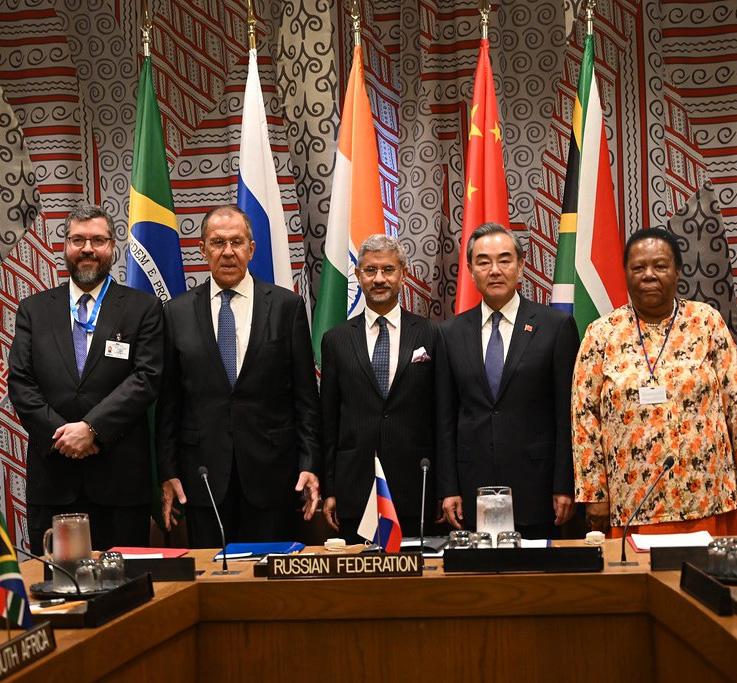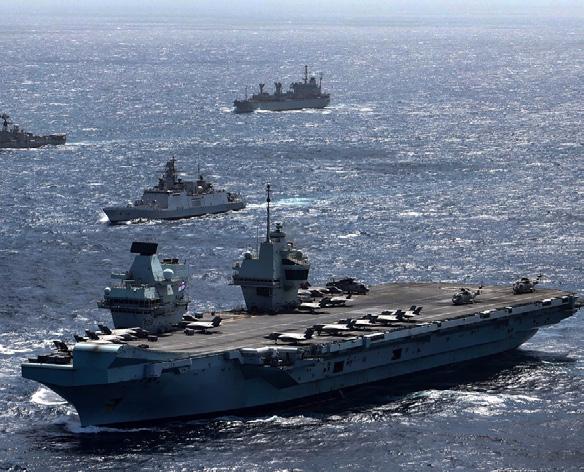
9 minute read
WORLD THIS WEEK
In collaboration with National Institute for Advanced Studies, Bengaluru
Authored by Harini Madhusudan, Rashmi Ramesh, Akriti Sharma and Ankit Singh, Padmashree Anandhan, Anu Maria Joseph, Femy Francis, Rishika Yadav, Jerry Franklin, Sreeja J S, Immaculine, R B Nithyashree, Lakshmi Parimala, Taffy Tonia, Subkish S and Melvin George
Advertisement
North Korea: Nuclear, Missile and now Space
Femy Francis
What happened?
On 31 May, North Korea’s first military reconnaissance satellite rocket Chollima- 1 witnessed a short ride, owing to the malfunctioning of the engine and fuel system. The debris of the satellite fell into the yellow sea after it flew for mere 10 minutes.
North Korean official media outlet KCNA said:” The new satellite vehicle rocket, Chollima-1, crashed into the West Sea as it lost propulsion due to an abnormal startup of the engine on the 2nd stage after the 1st stage was separated during normal flight.” This was North Korea's sixth attempt at launching a satellite, and the first espionage satellite mission into the orbit.
The failed launch led to a panic in South Korea and Japan where they issued an emergency, which was swiftly overhauled as the government's apologized for causing confusion and panic. The launch garnered a wave of criticism where Japanese PM Fumio Kishida said: “Any missile launches by North Korea, even if called a satellite, is a significant issue that affects the safety of Japanese citizens.”
UN Secretary General Antonio Guterres “strongly condemning that launch on 30 May — called on Pyongyang to refrain from conducting further satellite launches using such technology and swiftly resume dialogue to achieve the goal of sustainable peace as well as the complete and verifiable denuclearization of the Korean Peninsula,” issued UN’s official briefing. White House issued a statement: “The door has not closed on diplomacy, but Pyongyang must immediately cease its provocative actions and instead choose engagement.”
North Korea’s supreme leader Kim Jong Un’s sister Kim Yo Jong stated that Pyongyang would soon be successful in placing their military satellite into orbit. She further expressed that the international criticism of their test was “contradictory in nature", she believes: “The US is a group of gangsters who would claim that even if the DPRK launches a satellite... it is illegal and threatening.” The debris collect by the South Korean government found proof that ICBM technology was used to aid the launch and therefore violating the UNSC sanctions.
What does it mean?
The question arises as to why North Korea’s space ambition is threatening. Soon after the failure to launch they issued their conviction to re-launch and put the spy satellite on the orbit. Pyongyang observes the development of reconnaissance satellites is vital to deter US backed alliance of South Korea and Japan. They express that the US giant has established contradictory stance as they believe that they too face a looming threat in the region.
North Korea never ratified to the Non-Proliferation Treaty and therefore is not obliged to the same rules of disarmament. Therefore, the unilateral sanctions were imposed, but for North Korea, a usual defector of international law, it does not feel the need to comply with international law/ sanctions.
The threat from North Korea’s satellite and space ambitions are omnipresent as the larger ambition of reconnaissance technology is to aid the military and nuclear capability of the country. While the region and international community can deem the launch as a threat, North Korea will aim to develop its capacity to deter aggression.
North Korean espionage satellites would lead to breach of sensitive information and that sooner or later, the Korean peninsula and its allies will face a larger threat not limited to nuclear and missile.
The US: Debt Ceiling Notches up higher
Ankit Singh
What happened?
On 1 June, the US Senate approved Fiscal Responsibility Act by a 314/117 margin, allowing the US treasury department to issue T-bills, bonds and notes. There was no new limit set, rather the debt ceiling has been suspended till 2025. President Biden said:
“The agreement represents a compromise, which means not everyone gets what they want. That’s the responsibility of governing.” House of representative speaker McCarthy said: “It has historic reductions in spending, consequential reforms will lift people out of poverty into the workforce, rein in government overreach – there are no new taxes, no new government
programs.”
An assessment by Congressional Budget Office projected that the budget deficit would be reduced by roughly USD 1.5 trillion from 2023-2033, and reductions in discretionary outlays would amount to USD 1.3 trillion from 2024-2033.
What does it mean?
The US treasury securities are held in maximum number by Japan, followed by China and UK. Total treasury securities stands bought by other countries stands at USD 7.655 trillion and there is likely to be less buying from now onwards as the US looks within to funds to excessive debt. Reduced economic engagement in buying T-bills by developing countries will stagnate their progressive welfare policies. The debt regime will transition from lenient to stricter conditions across the world as the US shies away from its role due to internal and external political conditions. At the writing of this note, the NY Taxpayer and International Debt Crises Protection Act is making its way to the assembly in New York. The bill would constrain the New York State to invest in foreign entities and would entail corporate wisdom on restructuring loans and sharing losses. Inward-looking US federal government will likely dilute its financial clout in the global economy as China should emerge as another balancer. This might as well be the reason why the US will shy away from defaulting on its debt this once.
Regional Roundups
Singapore: Australian Prime Minister Anthony Albanese visits for Annual Leaders' Meeting and Shangri-La Dialogue
On 01 June, Australian Prime Minister Anthony Albanese embarked on a three-day official visit to Singapore for the 8th Singapore-Australia Annual Leaders' Meeting. During his stay, he will meet with Singaporean President Halimah Yacob and Acting Prime Minister Lawrence Wong, who will host an official lunch. The Annual Leaders' Meeting serves as a platform for discussing bilateral cooperation and exchanging views on regional and global developments. Due to Prime Minister Lee Hsien Loong's positive Covid-19 test, Mr. Wong will stand in as the host. Mr. Albanese will also deliver a keynote address at the Shangri-La Dialogue and receive an orchid hybrid named in his honor.
India: External Affairs Minister at BRICS foreign ministers meeting
On 01 June, External Affairs Minister S. Jaishankar urged BRICS nations to demonstrate sincerity in reforming the UNSC while he delivered his opening remarks at the BRICS Foreign Ministers meeting in Capetown, South Africa. India has been at the forefront of pressing the long-pending reform of the Security Council. He also said that the most important problem countries face is the “economic concentration that left too many nations at the mercy of too few.” He added that BRICS should give particular consideration and promote economic decentralization, essential for political democratization.
India: Akhand Bharat mural raises concerns in the immediate neighbourhood
On 02 June, External Affairs Ministry spokesperson Arindam Bagchi, at a media briefing, said that the Akhand Bharat mural depicts the spread of the Ashokan empire and Ashoka’s principles of ruling and governance. The mural has triggered controversies in India’s immediate neighbourhood as it comprises parts of their territories. Several Nepalese politicians reacted severely, and some even urged Nepalese Prime Minister Pushpa Kamal Dahal ‘Prachanda,' to raise the issue with New Delhi. Foreign Secretary Vinay Kwatra commented that the mural issue was not discussed between the two Prime Ministers since Prachanda is currently visiting India. Former Nepalese Prime Minister Baburam Bhattarai said that the mural depicting ancient India’s influence in the immediate neighbourhood could spark unnecessary diplomatic disputes.
Nepal: PM Dahal’s visit to India

On 31 May, PM Dahal embarked on his visit to India. Upon his arrival at the Indira Gandhi International Airport, he was welcomed by India’s Minister of State of External Affairs, Meenakshi Lekhi. He later met India’s National Security Adviser, Ajit Doval, and Foreign Secretary, Vinay Mohan Kwatra, at Hotel Maurya, where a few of the crucial issues agendas were discussed, which included boundary disputes, the EPG report and opening of new air routes. On 1 June, PM Dahal, on the 2nd day of his visit to India, met his Indian counterpart Narendra Modi, at Hyderabad House, in New Delhi. This most awaited meeting resulted in seven agreements and the launching of six projects. PM Modi reminisced about his first visit to Nepal in 2014, where he put forth a HIT formula, proposing Highways, I-ways, and Transways. He further stated that the two leaders had taken important decisions to make the friendship a ‘super hit’ in the future.
UAE: Withdrawal from a US-led coalition

On 31 May, the UAE Ministry of Foreign Affairs withdrew from a US-led maritime coalition called Combined Maritime Forces. The UAE highlighted its commitment to dialogue and diplomatic engagement to develop regional security and maintain stability. The withdrawal is crucial in regional geopolitics as the region poses some of the most important shipping routes. However, UAE has been an active participant in the US-led coalition. The Wall Street Journal reported that the UAE’s decision was taken as the United States failed to address the Iranian threats.
About the Authors
Harini Madhusudan, Rashmi Ramesh, Akriti Sharma and Ankit Singh are PhD scholars in the School of Conflict and Security Studies at the National Institute of Advanced Studies. Padmashree Anandhan, Anu Maria Joseph, and Femy Francis are Research Associates at NIAS. Rishika Yadav, Jerry Franklin, Sreeja J S, Immaculine, R B Nithyashree, Lakshmi Parimala, Taffy Tonia, Subkish S and Melvin George are Research Interns at NIAS.









